Battery Pack Cooling System
There are three main cooling methods of battery pack cooling system:
1. Natural cooling: This method mainly uses the radiator (or cooling plate) of the battery system to absorb and dissipate the heat generated by the battery core, and achieves heat dissipation through heat convection and heat conduction. Natural cooling relies on the reasonable structural design of the battery system. The radiator can quickly and effectively transfer the heat generated by the battery core to other parts of the entire battery pack, and then other parts conduct the heat to the external environment. However, the effect of natural cooling is greatly affected by factors such as ambient temperature and wind speed, and the efficiency is relatively low.
2. Liquid cooling plate cooling: This is a common method of cooling battery packs. Its working principle is to directly install single cells or cells into a battery pack shell made of materials with high thermal conductivity, and the cells pass through the radiator. To absorb and dissipate heat, the heat source circulates through the liquid cooling plate (a material with high thermal conductivity), transferring the heat to other parts of the battery pack, and then other parts conduct the heat to the cooling channels, and finally the heat is discharged from the battery Outside the package. This method can effectively dissipate the heat generated by the battery core quickly, thereby maintaining the stability and safety of the battery pack. The heat dissipation efficiency of liquid cooling plate cooling is greatly affected by factors such as the flow rate of the liquid and the thermal conductivity of the radiator.
3. Phase change material (PCM) cooling: The phase change material cooling method is to use phase change material (PCM) in local areas of the battery pack. When heat is generated in the battery pack, the phase change material absorbs or releases heat to adjust. Battery pack temperature. For example, when the temperature of a part of the battery pack rises, the phase change material will absorb this part of the heat, convert it into a solid or liquid state, and release it to other areas of the battery pack, thereby lowering the temperature of this part. This method has better temperature regulation capabilities and can effectively improve the energy density and life of the battery.
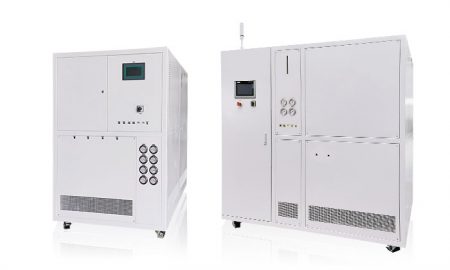
Sistemas de controlo de temperatura e caudal para aquecimento/arrefecimento
Simulação da temperatura para o ensaio da qualidade do veículo: ensaio da duração da bateria, banco de ensaio do injetor/motor de combustível, ensaio do airbag, banco de ensaio de componentes, etc.
| Gama de temperaturas | -25°C ~ +100°C | -40°C ~ +100°C | 0°C ~ +100°C | -40°C ~ +135°C | |||||
| Capacidade de arrefecimento | 2,8 ~ 38kW | 1,2 ~ 60kW | 1,8 ~ 60kW | 4 ~ 60kW | |||||
| Nota: Qualquer faixa de temperatura de -150 ℃ ~ +350 ℃ e qualquer capacidade de resfriamento pode ser personalizada | |||||||||
A temperatura / pressão / caudal podem ser controlados de forma independente
1&2: uma máquina para o controlo de dois grupos
| Gama de temperaturas | -40 ~ +100℃ 1&2 | 0 ~ +100℃ 1&2 | |||||||
| Capacidade de arrefecimento | 1,8kW*2 ~ 60kW*2 | 1,8kW*2 ~ 60kW*2 | |||||||
| Nota: Qualquer faixa de temperatura de -150 ℃ ~ +350 ℃ e qualquer capacidade de resfriamento pode ser personalizada | |||||||||
A temperatura mantém-se constante, a pressão / caudal podem ser controlados de forma independente
1&3: uma máquina para controlo de três grupos
1&6: uma máquina para controlo de seis grupos
| Gama de temperaturas | -40 ~ +100℃ 1&2 | -40 ~ +100℃ 1&3 | -40 ~ +100℃ 1&6 | -20 ~ +100℃ 1&6 | 0 ~ +100℃ 1&2 | 0 ~ +100℃ 1&3 | 0 ~ +100℃ 1&6 | ||
| Capacidade de arrefecimento | 2,5 ~ 60kW | 4 ~ 60kW | 10 ~ 60kW | 10 ~ 60kW | 7 ~ 60kW | 11 ~ 60kW | 18 ~ 60kW | ||
| Nota: Qualquer faixa de temperatura de -150 ℃ ~ +350 ℃ e qualquer capacidade de resfriamento pode ser personalizada | |||||||||
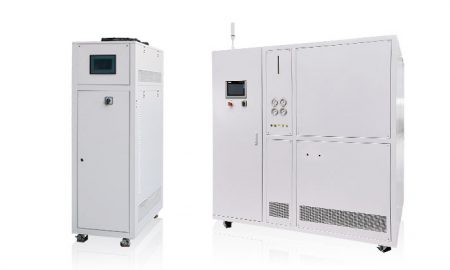
Refrigeradores de óleo
Simulação da temperatura para o ensaio da qualidade do veículo: ensaio da duração da bateria, banco de ensaio do injetor/motor de combustível, ensaio do airbag, banco de ensaio de componentes, etc.
| Gama de temperaturas | 0℃ ~ +160℃ | +5℃ ~ +135℃ | |||||||
| Capacidade de arrefecimento | 11 ~ 60kW | 15 ~ 38kW | |||||||
| Nota: Qualquer faixa de temperatura de -150 ℃ ~ +350 ℃ e qualquer capacidade de resfriamento pode ser personalizada | |||||||||
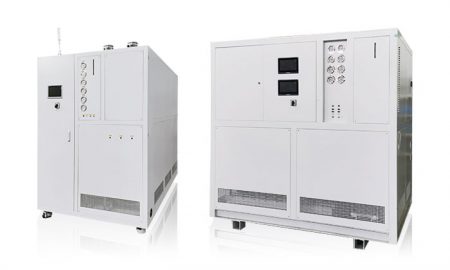
Sistemas de arrefecimento e aquecimento para bomba eletrónica
| Gama de temperaturas | -40°C ~ +135°C | ||||||||
| Capacidade de arrefecimento | até 60kW | ||||||||
| Nota: Qualquer faixa de temperatura de -150 ℃ ~ +350 ℃ e qualquer capacidade de resfriamento pode ser personalizada | |||||||||
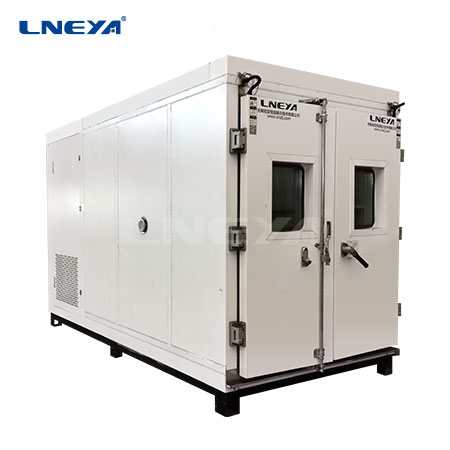
Câmara de teste de bateria com temperatura alta e baixa
| Gama de temperaturas | -40℃ ~ +100℃ | -40℃ ~ +100℃ | |||||||
| Capacidade de arrefecimento | 1,8 ~ 7,5kW | 4 ~ 15kW | |||||||
| Nota: Qualquer faixa de temperatura de -150 ℃ ~ +350 ℃ e qualquer capacidade de resfriamento pode ser personalizada | |||||||||
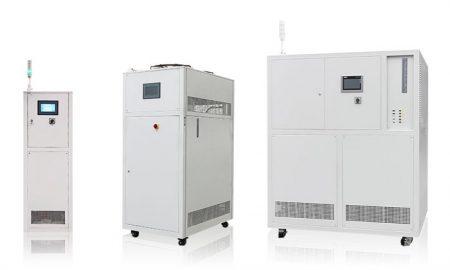
Sistemas de arrefecimento ou aquecimento direto para automóveis
| Tipos | Arrefecimento direto | Arrefecimento e aquecimento directos | |||||||
| Capacidade de arrefecimento | 5 ~ 10kW | 5 ~ 10kW | |||||||
| Nota: Qualquer faixa de temperatura de -150 ℃ ~ +350 ℃ e qualquer capacidade de resfriamento pode ser personalizada | |||||||||
 LNEYA
LNEYA
 简体中文
简体中文

















































































